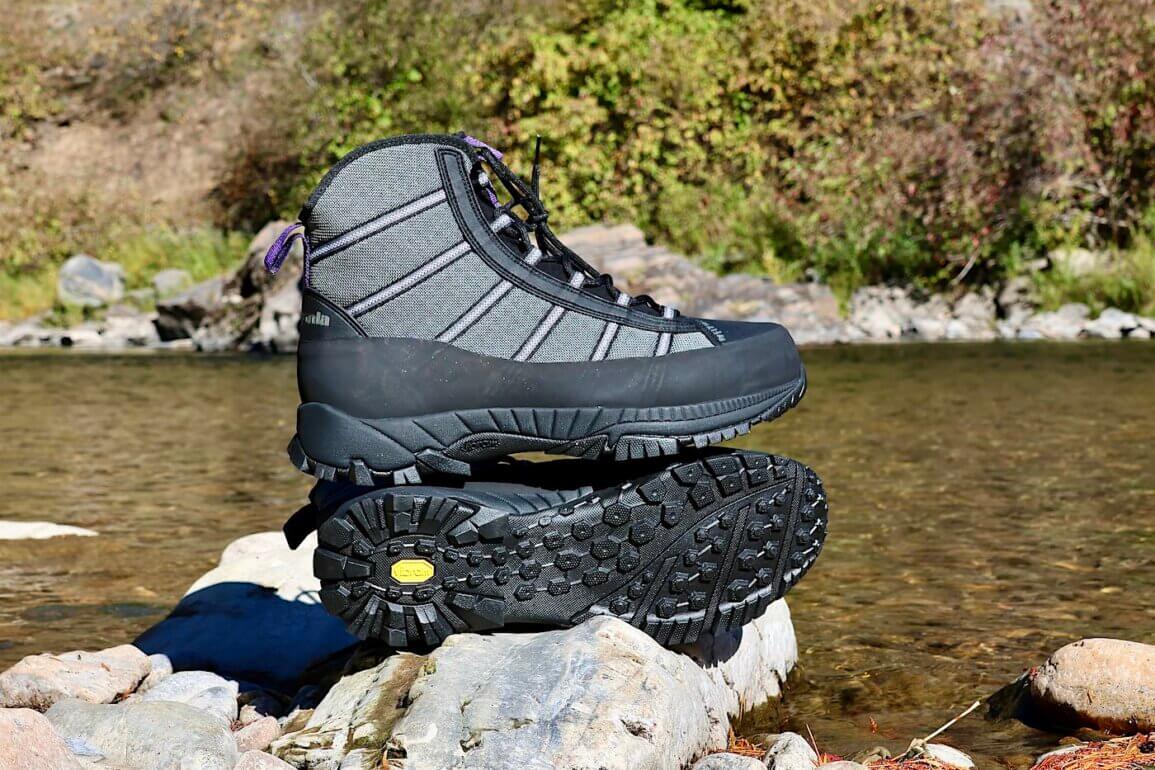The Patagonia Forra Wading Boots are lightweight, comfortable and surprisingly supportive.
To get us a closer look, Patagonia sent us a pair of its new Forra Wading Boots to review last fall. Man Makes Fire gear reviewer Chris Maxcer took them out fly fishing on Idaho rivers to test their real-world performance. To help you determine if the Patagonia Forra Wading Boots are right for you, here is what he learned and here are his buying recommendations:
Review: Patagonia Forra Wading Boots
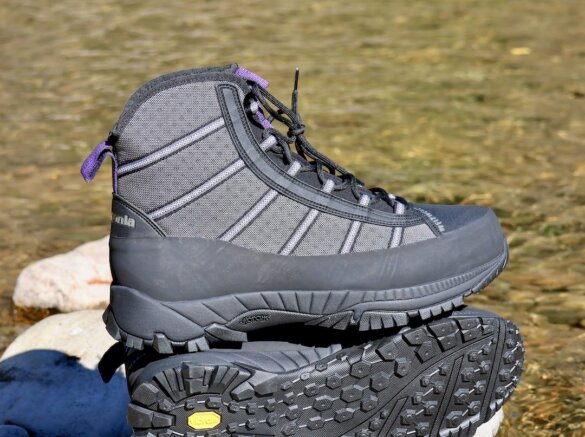
The Patagonia Forra Wading Boots are something special. The moment I first slipped them on — sitting on the rocky banks of the St. Joe River in Idaho — I was amazed at how well they fit. Out-of-the-box comfort was just outstanding. The Forra felt more like a hiking boot than a wading boot — and I had this impression even though I was wearing stockingfoot waders with neoprene booties!
Seriously, I was more impressed with the initial fit and feel of the Patagonia Forra Wading Boots than I have been with dozens of other competitive wading boots over the years.
As it turns out, we can likely credit that fit to the fact that the Forra Wading Boots are actually manufactured by Fitwell in Italy for Patagonia. The Italians make good footwear, no doubt about it.
Agility Over Rugged Terrain
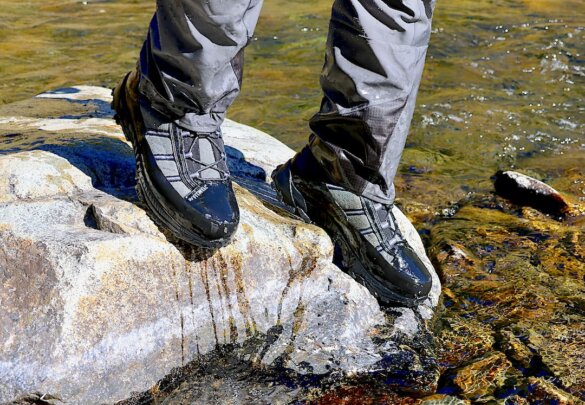
As I’ve tested more and more wading boots — and have gotten older and wiser — I’m starting to prioritize lightweight footwear that feels more nimble and agile. Part of this is the rugged Idaho terrain I tend to frequent — steep banks, lots of boulders, plenty of logs and deadfall to climb over. In addition, there aren’t as many long, smooth runs where you can spend hours simply fishing from the same spot. For example, I can fish half a day on the Owyhee in Oregon where the fish density is amazing . . . and never stray more than 80 yards up or down river. But in Idaho I’m covering more ground — and maybe even climbing into and out of rafts along the way.
For fishing on the go, the Patagonia Forras are fantastic.
And that’s what Patagonia created them for — covering ground on the trail, scrambling around rocks and boulders, and getting to hard-to-reach fishing holes. This makes sense because Patagonia already has great heavy-duty boots — it’s Foot Tractor Wading Boots and River Salt Wading Boots made in the USA by Danner. The Foot Tractors weigh more than twice as much as the Forra boots . . . and even the River Salt boots weigh nearly a full pound more than the Forras.
When it comes to swing weight for high-quality fly fishing rods, lighter is better because it means you can more easily cast a fly rod repeatedly all day long without feeling as tired. Swing weight for wading boots works the same way: If you’re taking a lot of steps and lifting your feet up and over terrain all day long, lighter boots can help.
Support and Stability

On the other hand, sometimes lighter gear isn’t strong or stable enough to last. I found that Fitwell did a fantastic job with the Cordura nylon mesh upper. It doesn’t look like much, but it’s surprisingly stable. I think a big part of the stability is the relatively rigid footbed, the heel pockets and how easily the laces cinch up throughout the boot.
The nylon upper is relatively thin compared to most wading boots. It’s also packed with mesh-like holes that let it drain and dry fast. Before you put these on and lace them up, you might question the ankle support and stability. I think everyone but those with chronic ankle-sprains will like them a lot.
The rubber Vibram Mars sole doesn’t extend out from your foot much, so they tend to have a more nimble feel than boots that have extra wide soles like the Foot Tractors. If you like hiking boots more than heavy work boots, you’ll like the Patagonia Forra Wading Boots.
Traction
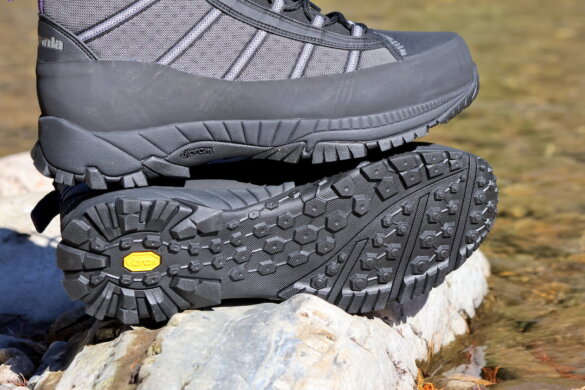
Traction on dry rock, dirt, logs, gravel, sand, grass, and mud is very good.
In water traction on round slick Idaho rocks that sometimes feel like a bed of bowling balls . . . is only about average for competitive rubber wading boots soles. Sorry. If you tend to wade on wet slimy-smooth rocks, you’ll likely need to add Patagonia’s Grip Studs Traction Kit.
I think the HexaBase lugs help grip on odd angles on terrain, and the aggressive edge lugs do a great job when you’re going down steep river banks. You know your own home water rivers better than I do, and if you need felt soles to feel safe on the rivers you fish most, you’ll likely need to add some tungsten-carbide studs to the Forras.
Of course, felt vs rubber soles is a whole other issue: Some states have banned felt soles due to concerns over invasive species hitching rides, so if you fish in one of those states, you don’t have a choice to use felt. Either way, to help prevent the spread of aquatic invasive species, responsible anglers should always thoroughly inspect, dry and/or disinfect their wading boots and gear before traveling from one watershed to another.
The only issue I have with using studded rubber-soled wading boots is using them in rafts and drift boats. So studs aren’t a solution for everyone or every river.
Shop Patagonia here for all Forra size options, the Forra Stud Kit and FREE Shipping!
Build Quality
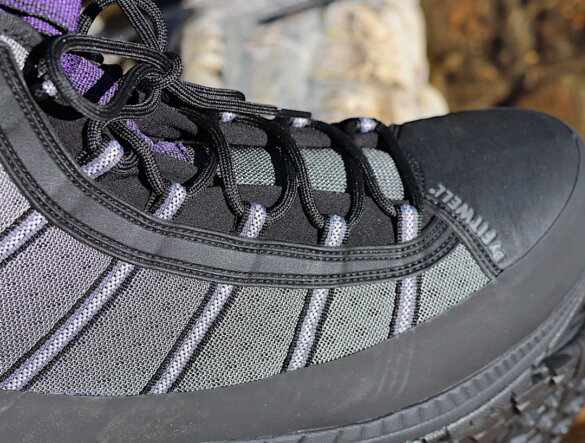
The overall build quality is excellent. The full-coverage rand protects the boot from sharp rock and debris — and removes any sewn seams that can catch and fray over time.
The upper forefoot and heal stitching is recessed to protect those stitches. If there is any point of failure you might be concerned with, it’s probably the fabric laces instead of hardware-based eyelets. They may eventually wear through. If you travel with these boots and wear them in saltwater, you’ll appreciate the noncorrosive laces. I’m not sure how many miles you can expect to get out of the Forras — or when normal wear and tear might kick in around Patagonia’s Ironclad Guarantee — but I am pretty sure that you’ll enjoy wearing these boots if you’re fishing a lot of miles.
Drainage
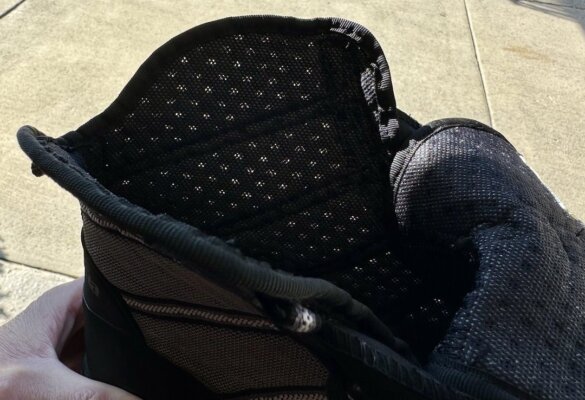
The Patagonia Forras drain well due to the porous uppers. Water squishes out easily.
The biggest difference from most competitive wading boots is that the Forras don’t have any lower-level drain holes. There are zero holes down through the sole itself, and there are no drainage holes just above the insole. For example, lots of boots have a few holes punched in just below the arch.
When I was testing the Forras, I was initially a little worried about drainage. After testing the Forras in and out of the water, back and forth over rocky riverbanks, it turns out that real-world drainage was surprisingly good. A bit of water does stay in the bottom for a while, but it’s not bothersome and the overall relatively snug fit doesn’t result in much sloshing.
Shop Patagonia here for all Forra size options, the Forra Stud Kit and FREE Shipping!
Sizing: True-to-Size Snugness
In my experience, the Patagonia Forra fits true-to-size. The toe box is roomy and the forefoot is snug but not tight. I could wear them with the relatively thick booties of the Patagonia Swiftcurrent Expedition Waders as well as the Grundéns Boundary Stockingfoot Waders with comfort. Similarly, with thinner Korker’s I-Drain Booties, I wore my usual size 14 just fine, too, by lacing them a bit tighter.
Choose the same size Forra as your regular sized street shoe or hiking boot and you should be good to go. However, if you have a wide foot and you want to wear heavy socks, you might need to size up.
Competitive Alternatives & Options
There are many high-quality competitive wading boot options we recommend. However, there are only a handful of high-quality ultralight wading boots that are designed for similar fishing needs. If you are considering the Patagonia Forra Wading Boots, these alternative options might also meet your needs:
Simms Flyweight Access Wading Boot — The Simms Flyweight Access Wading Boot weighs in at just 42 ounces for a size 11 — very competitive to the Forra’s 41-oz reported weight (unknown size, but typically a 10 or 11). Overall design compared to the Patagonia Forra is similar — very few seams, fabric eyelets, thinner uppers. The key difference may be the formula of the Vibram Idrogrip Flex outsole, which Simms says is engineered to be softer and grippier than other Simms wading boots. In fact, Simms warns its customers that these soles will wear out faster than its other boots. Simms even will re-sole the boots for about a $100 if you wear them out.
Simms Flyweight Wading Boot — This Flyweight version preceded the Flyweight Access and it’s still a popular boot. In fact, it’s one of my favorites — read my original full Flyweight review here. The Patagonia Forra has better off-trail action than the Simms Flyweight. In-water traction on slick, slimy rocks is similar.
Orvis Ultralight Wading Boot — The Orvis Lightweight Wading Boot weighs in at 40 ounces per pair of size 10 boots. They have a chunkier, wider design and sole than the Patagonia Forra boots. The ankle is a bit lower, which is great for agility. The Forra offers slightly better ankle support. Traction is similar on both terrain and in-water. Full review here.
Orvis PRO LT Wading Boots — The new Orvis PRO LT Wading Boots are similar to the Orvis Lightweight version, but they feature a 360-degree rand design that is more similar to the Patagonia Forra’s sole and rand.
Korkers Chrome Lite BOA — The new Korkers Chrome Lite BOA Wading Boots show a lot of promise. They are lightweight like the Forras but they feature a BOA lacing system. Unlike most Korkers with interchangeable soles, the Chrome Lite BOA has a fixed rubber sole. The sole pattern is less aggressive than the Forra sole, but Korkers adds a lot of siping for slick rock traction and breaks the sole into six large lugs for traction on mud and terrain.
The Verdict: Best Lightweight Wading Boot for Hiking
The Patagonia Forra Wading Boots are our current favorite lightweight wading boot. If you hike over rugged terrain to get to your fishing spots or explore long stretches of riverbank, you’ll love the hiking boot-like fit and feel of the Italian-made Forras. The overall Forra fit and agility is simply outstanding. Over ground, the traction is awesome. In water traction on smooth, slimy rocks is about average for rubber-soled wading boots. If your rivers require it, you can add studs for extra bite. If you want to reduce the weight of your wading boots, the Patagonia Forras are an easy win. Very highly recommended.
Get the Gear:
- Patagonia Forra Wading Boots – men’s
- Patagonia Forra Wading Boots – women’s
Shop more Patagonia Forra buying options at:
AvidMax | Backcountry | Patagonia
Our Gear Review and Tester’s Specific Related Experience:
Chris Maxcer has tested and reviewed dozens of wading boots and stockingfoot waders for Man Makes Fire. He’s personally worn and tested wading boots while fly fishing in Idaho, Oregon, Washington, Montana, Colorado, and Alaska for trout, salmon, steelhead, and smallmouth bass. Of course, Maxcer has also written hundreds of in-depth outdoor gear reviews, including independent, first-hand reviews of fly fishing gear, camping gear, hunting gear, backpacking gear, and beach and water play gear. He believes the best way to understand a product is to use it in the real world for the kind of activity it was designed for.
Man Makes Fire publishes independent gear reviews, unencumbered by any requirements from any gear brand or manufacturer.

